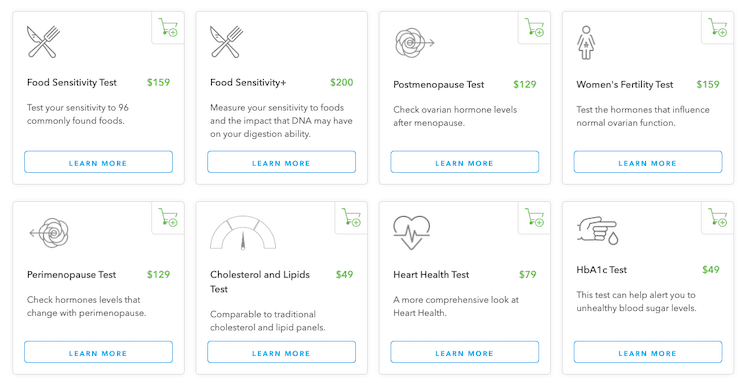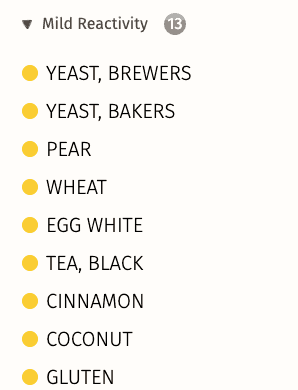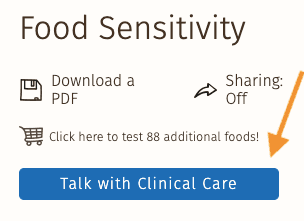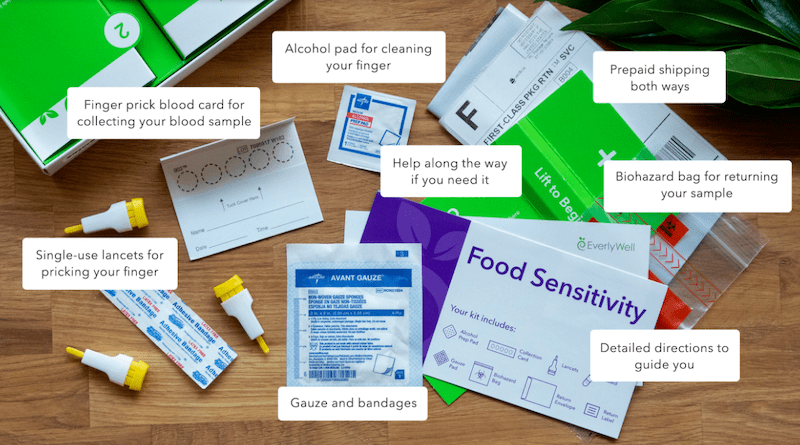What Are We Reviewing? The EverlyWell Food Sensitivity Test, which uses an at-home blood sample (via finger prick) to test for 96 food sensitivities.
As someone who has done several rounds of Whole30, I’m used to trying to assess my food intolerances. Was it that milk with my cereal that set my stomach grumbling at lunch? Or was it the beer I had last night?
Whole30 is definitely a great way to find out your food intolerances, but you can really only do that by correctly following the reintroduction phase (this is when you slowly re-introduce food groups into your diet again and assess how they affect you).
I’m ashamed to say that there have been a few occasions where I did a round of Whole30 and, upon completion of the program, went bananas and ate ALL THE FOODS.
Unfortunately, this kind of misses the whole point of Whole30 – which is to spend 30 days cleaning your body of high-risk foods so that you have a clean slate to start with when you reintroduce foods and see how those foods make you fee.
Well, if you’ve had a hard with with the reintroduction phase, I don’t blame you because of course I have had a tough time with it too!
For those who prefer a bit of a shortcut, EveryWell’s Food Sensitivity Test may be worth a try.
What is EveryWell?
EverlyWell provides DIY health tests and screenings, allowing you to get tests that would normally require a doctor’s visit from the comfort of your own home.
EverlyWell offers a huge array of tests (over +30), including:
- Food Sensitivity Test (the one I did, and which this review is based off of)
- Sleep & Stress Test
- Thyroid Test
- Metabolism Test
- Vitamin D Test
- & many more

The sample collection method will vary depending on the test. Collection methods include:
- Blood sample (sample method for the Food Sensitivity test)
- Urine sample
- Saliva sample
While these types of do-at-home-and-send-it-in tests are somewhat controversial, I’m a huge fan of individuals taking a bit more control into their hands and getting knowledge that will enable them to be their own health advocates.
Obviously this isn’t to say you can’t or shouldn’t trust your doctor – of course you should, and in fact EverlyWell recommends going over your test results with a trusted doctor, especially if you see some red flags.
However, for me, these probably aren’t tests I would go to the doctor for, but am still curious about regardless. An at-home blood test reduces friction and allows me to get test results without all the rigmarole of a doc visit.
Since I’ve been trying to learn a lot more about my food intolerances, EverlyWell’s Food Sensitivity test seemed like a great start.

EverlyWell Pricing: How Much Are the Tests?
Most EverlyWell tests are priced between $50 – $200. The Food Sensitivity Test is $159 (at the time of writing this article).
It’s also worth noting that Everlywell does accept HSA and FSA payments. You also don’t need to pay for shipping on either end.
DISCOUNT: You can also get 15% off ANY TEST when you purchase an Everlywell test with this link and code LIFEHEALTHHQ.
How Does EverlyWell’s Food Sensitivity Test Work?
EverlyWell’s Food Sensitivity Test works by measuring your body’s immune response to 96 foods. More specifically, by measuring your body’s Immunoglobulin G (IgG) response. Some studies have shown that an igG response may be responsible for frustrating symptoms like headaches, joint pain, eczema, gut malabsorption, etc.
Some things to keep in mind for the Everywell Food Sensitivity Test:
- Real physicians will look at your test. Tests are reviewed by an independent board-certified physician within your specific state.
- Certified labs that are used by hospitals. Tests are done at CLIA-certified labs (Clinical Laboratory Improvement Amendments). These labs have a high level of state and federal standards they must meet for approval.
- Easy + reliable home sample collection (yes, even blood). While it may seem hard to believe that you can reliably collect a blood sample at home, EverlyWell uses well-established home collection methods and only offers tests that can reliably and validly work with at-home collections.
- Get tested for more foods (if you want). While the standard food sensitivity test measures your response to 96 foods, you can do an upgrade to 200 foods if you pay extra. I stuck to 96 version, which seemed to cover every food I could think of. But the 200 foods upgrade may be worth it if you want to do the full dive.
Stop any diets before doing this test!
Eat all foods you want to be tested for 30 days prior. The test will only be able to evaluate foods you’ve eaten in the last 30 days, since that’s how long the food will be detected in your bloodstream.
This was not made clear to me before I did my blood sample, so thank goodness I haven’t been on Whole30!
This means you don’t want to be doing Whole30 or any other kind of specialized diet before taking the test. Make sure to get the most out of your test by eating your full range of foods for 30 days before providing your blood sample!
My Experience Taking the EverlyWell Food Sensitivity Test
The EverlyWell test requires a blood sample and I’ll be honest, just seeing the world “blood sample” freaked me out a little. I already don’t like getting my blood taken at the doctors. I’ve almost fainted a few times. Doing it myself? Yikes!
However, in practice, getting a blood sample for the EverlyWell test was easy. It just require a simple finger prick, and truthfully it didn’t hurt any more than a nasty insect bite.
The sample collection process involves dripping your blood onto a few circles on a piece of paper that EverlyWell provides. Once the paper dries, you send in the sample with your blood, and EverlyWell runs the test and posts your results on your private online dashboard.
I did a video review (seen here) showing the sample collection process, as well as my overall thoughts about the test (which I go into detail about more below).
My EverlyWell Food Sensitivity Results: Was it Worth It?
My EverlyWell report showed that I had a mild reactivity for 13 foods, and a low intolerance for 83 foods.

I’ll admit I was actually a bit disappointed at first – I wanted to see some highs or at least some moderates! I wondered – was it even worth trying to eliminate these foods if they were just mild reactivity levels? What does a “mild” reactivity level mean anyway?
Well, getting these questions answered was a bit more difficult than I thought it would be. While there is a decent amount of information available in the EverlyWell dashboard, a lot of it involves how to conduct an elimination test, what an elimination test is, etc.
I was really having a difficult time understanding my results – aka what does mild reactivity (vs high, moderate, and low) really mean?
No information in my results dashboard was very helpful in answering this, so I decided to jump on the EverlyWell Facebook Group.
Joining the EverlyWell Facebook Group
Facebook Groups are fantastic.
I love our Whole30 Crush It Club Facebook Group – there are so many people there willing to help one another, and the community I’ve seen grow there is incredible.
Since I’m a big fan of Facebook Groups, I was psyched to see that EverlyWell has their own EverlyWell Community Facebook Group.

I definitely recommend joining this Facebook group when your test results come in. It’s really interesting to see how your results compare to other people’s. Plus, it can be nice to commiserate over the potential need to cut out red wine (or your favorite breakfast egg dish).

On top of that, there are official EverlyWell moderators in the group who can help answer questions you might have and who will shed some additional light on what your test results mean.
Scheduling a Call with an EverlyWell Clinical Care Member
Unfortunately, while the moderators there are great about answering most questions, I was still having a tough time explaining my area of confusion, so I scheduled a call with a EverlyWell Care Clinician team member to discuss my results in more detail.

I really recommend doing this – this is an awesome service that EverlyWell offers for free, and you should take full advantage of speaking with someone who can help you get the most out of your test results!
The calls are limited to 15 minutes, but I didn’t find myself needing anymore time than that.
I mostly did the call because I still didn’t understand what the different reactivity levels mean.
I asked once again if “mild” is a measure of how powerfully my body reacts to the ingredient, or if it is a “mild” a measure of how likely the ingredient is to affect me at all? Unfortunately, my clinician care representative gave me the same line – that the reactivity level is simply based on igG levels.
However, she also explained that it’s not a 1-1 ratio and that everyone is different. Some people have a strong reaction to even mild reactive foods, and eliminating them can make a difference. For others, not so much.
If that’s the case, I can’t help but wonder what the point is of having the reactivity scale at all. If mild vs moderate vs high are meaningless attributes out of a scientific measurement of igG, and doesn’t actually mean anything for an individual looking to asses their food intolerances, than why not just have foods come up as a “yes” or “no” for reactivity?
My clinician’s answer was that the reactivity scale gives people a place to start from. So if you had several high foods, it would make sense to start with eliminating those, and then go to moderates and milds.
I didn’t feel completely 100% satisfied with these answers, but I suppose they will have to do. And to be fair, I’m no scientist, so science-speak tends to make my brain turnoff, which is the igG levels are meaningless to me.
EverlyWell Review: Food Sensitivity Test Pros & Cons
The Everlywell tests are an awesome idea – I really love seeing people being empowered to take their health into their own hands.
Because let’s face it, while most doctors and health care professionals are awesome people, there will always be some bad apples, and unfortunately healthcare is one of the fields where it’s easy to confuse the public because most of us don’t have a medical degree!
The EverlyWell Food Sensitivity test has some powerful advantages. It can:
- Jumpstart your elimination diet! The EverlyWell test lets you begin your elimination diet with some likely food culprits, narrowing down the huge amount of foods you could potentially work on eliminating.
- Give you food culprits outside of Whole30. I was surprised to find potential intolerances that you’d never find on Whole30. For example, my report shows an intolerance for eggs, coconut, pear, and black tea – all things that are 100% Whole30 compliant!
However, there are a few issues I have with the test. And I will fully admit that maybe this is just me being paranoid and not understanding my results, but this is my two cents.
The paranoid sceptic in me wondered if I was being told what would make me feel good about taking the test vs. what was factually accurate.
I tried so hard to get an answer on what the “mild” intolerance rating means in an actionable, practical, real-world sense – not as a scientific number that mens nothing to me. But I was just told that is basically doesn’t mean anything from a practical standpoint and that “it’s different for everyone”. And I don’t doubt that’s true…
But I imagine the “mild” rating must mean something, otherwise why would it exist? I would be totally OK with being told that most people don’t find mild reactivity level foods to have a strong effect on them – I’d still be happy I took the test to know.
My fear is that they give the answer that “it’s different for everyone” just so I can be satisfied about taking the test. But it’s hard to say. I’m sure mild reactivity level foods really do totally vary for different folks, but I’d still like to know how generally how often people find mild reactivity foods affecting them, etc. This is the kind of info I would really have liked to see provided by EverlyWell!
I also found it strange that “low reactivity” basically means “normal response.” That wasn’t made clear to me until the clinician explained over the phone. I found it pretty odd that wasn’t clear on the results dashboard anywhere. I can’t help but wonder if they are purposefully with-holding information so that I feel I’m getting more out of my test results.
Who knows, maybe I’m just being a bit jaded.
While I would have appreciated a bit more insight into how the different reactivity levels work in a practical sense, I still found the EverlyWell test pretty cool. I’m excited to start eliminating those mild reactivity foods from my diet and to see the results!
EverlyWell Food Review: Is Worth It?
EveryWell is definitely worth a try if you want a head start for your elimination diet.
It’s a great option for those who aren’t quite up for doing a round of Whole30 but want more insight into their food intolerances.
These results can be a really helpful starting point for a proper food elimination diet.
If you do take the EverlyWell test, make sure to also schedule a Clinician Care call once your results come in, and also join the Everlywell Community Facebook Group. It’s helpful to see how your results compare to others and commiserate with any red-flag food groups you might have to give up.
Also don’t forget, you can get 15% OFF using code LIFEHEALTHQ




